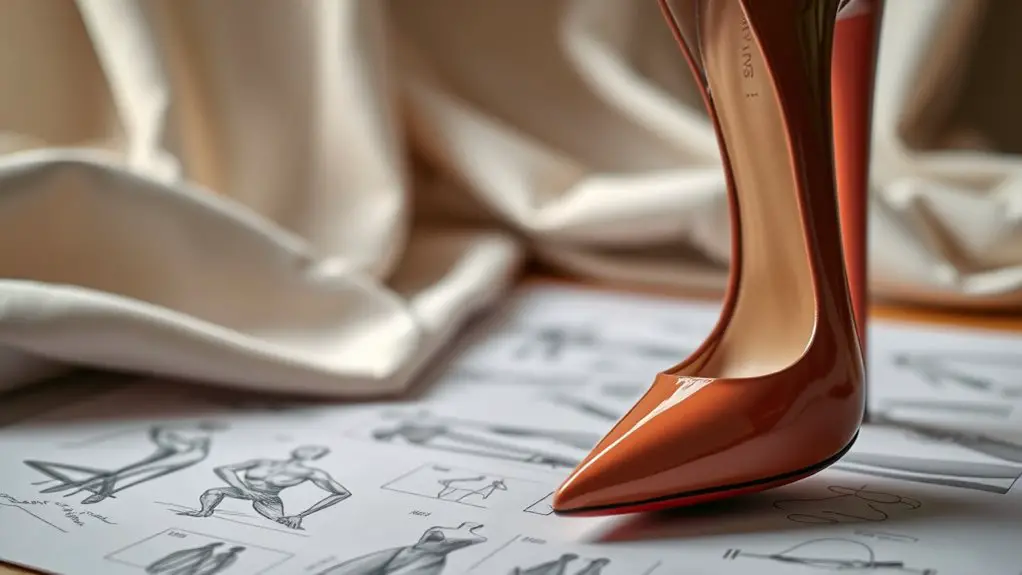The most difficult part of designing a stiletto heel is balancing foot anatomy with aesthetic appeal. You need to take into account factors like arch support, heel height, and stability to guarantee comfort while maintaining an elegant profile. Selecting the right materials is essential for performance and sustainability, enhancing wear resistance without adding weight. Achieving that perfect fit often involves tackling unique foot shapes and preferences. There’s much more to explore in the intricate world of stiletto design.
Understanding Foot Anatomy

When designing a stiletto heel, understanding foot anatomy is vital. You’ve gotta appreciate the intricate foot structure, which consists of bones, joints, and soft tissues that work together to support movement. Each foot is unique, so recognizing anatomical variations—like differences in arch height and toe alignment—can greatly influence your design. For instance, people with high arches may need additional cushioning or support to prevent discomfort while wearing your stiletto.
Moreover, consider how the metatarsal bones bear weight; improper distribution can lead to pain and instability. It’s important to create a design that accommodates different foot shapes while maintaining elegance. By carefully analyzing these factors, you guarantee your stiletto heel not only looks stunning but feels comfortable, too. Balancing aesthetic appeal with anatomical considerations can elevate your design to a new level, making your stiletto a favorite choice among wearers.
Balancing Height and Stability
When designing a stiletto heel, you have to strike a delicate balance between height and stability, especially considering foot anatomy. Selecting the right materials can make or break your design, influencing both comfort and performance. Innovations in heel design can enhance stability while still giving you that desired elevation, ensuring you don’t sacrifice style for safety.
Foot Anatomy Considerations
Although designing a stiletto heel often prioritizes aesthetic appeal, understanding foot anatomy is essential for achieving both height and stability. Your foot structure plays a significant role in how pressure points distribute weight, impacting comfort and balance.
| Foot Anatomy Component | Function | Design Consideration |
|---|---|---|
| Metatarsals | Weight-bearing | Supportive arch design |
| Phalanges | Toe flexibility | Sufficient toe box space |
| Arch | Shock absorption | Proper heel height |
| Heel Pad | Cushioning | Soft materials to minimize impact |
| Ankle | Stability and support | Adjustable straps for security |
Material Selection Challenges
Selecting the right materials for a stiletto heel is a delicate dance between achieving the desired height and ensuring stability. You’ll want to explore sustainable materials that offer both luxury and functionality. Consider innovative composites that provide wear resistance while remaining lightweight. Performance textiles enhance moisture management, essential for comfort during wear. Eco-friendly options can elevate your design without sacrificing style. Don’t forget about colorfast materials that maintain vibrancy through varied texture variations. By blending these elements, you can craft a heel that balances breathtaking height with reliable support. Whether using rich luxury fabrics or advanced performance textiles, each choice impacts both aesthetic appeal and the shoe’s overall performance, making material selection a significant challenge in stiletto design.
Heel Design Innovations
The intricate balance of height and stability in stiletto heel design is where innovation truly shines. To achieve the perfect combination of elegance and support, designers are utilizing innovative materials and techniques that redefine what’s possible. Here are three key innovations enhancing heel height without compromising stability:
- Carbon Fiber Reinforcement: This lightweight material provides exceptional strength while minimizing weight, allowing for taller heels without the bulk.
- Shock-Absorbing Cushions: Integrating advanced cushioning systems can enhance comfort, ensuring your feet feel good even with heightened elevation.
- Wider Heel Bases: By slightly widening the base of the heel, designers maintain a sleek appearance while increasing stability, making those daring heights more manageable.
With these innovations, you can enjoy stunning stilettos that don’t sacrifice comfort for style.
Selecting the Right Materials
When you’re designing a stiletto heel, choosing the right materials can make all the difference between a stunning creation and a shoe that falls flat. You’ll want to take into account not just aesthetics but also functionality and sustainability. Opting for sustainable materials like organic leather or recycled synthetics can enhance your brand’s eco-credentials, appealing to environmentally conscious consumers.
Innovative textiles, such as breathable mesh or flexible knits, can provide comfort without sacrificing style. These materials can help reduce fatigue during wear, allowing your design to stand out in both form and function. When experimenting with textures, think about how they interact with light—reflective surfaces can add a touch of glamour, while matte finishes offer sophistication. Remember, the right combination of materials can elevate your stiletto heel into a true work of art, ensuring it’s as impressive on the foot as it is on the runway.
Crafting the Perfect Arch

While you might focus on the heel height and toe shape, crafting the perfect arch is essential for both aesthetic appeal and wearability. Achieving the ideal balance requires precision and a keen understanding of arch design techniques. Here are three key considerations to keep in mind:
- Optimal Arch Height: The height should complement the overall design while providing adequate support. Too high, and it becomes impractical; too low, and it loses elegance.
- Foot Anatomy: Understanding the natural curves of the foot helps in creating an arch that fits comfortably, enhancing both beauty and function.
- Material Selection: The choice of materials influences the flexibility and stability of the arch. A well-chosen material can elevate the design while ensuring durability.
Designing for Comfort
When designing a stiletto heel, you can’t overlook the importance of arch support; it’s essential for both style and comfort. Selecting the right cushioning materials can make all the difference, allowing you to enjoy that killer heel without sacrificing your feet. Let’s explore how these elements come together to create a perfect blend of elegance and ease.
Arch Support Considerations
Although many might prioritize aesthetics when choosing a stiletto heel, incorporating effective arch support is essential for ensuring comfort during wear. To achieve this, consider the following:
- Arch Support Technologies: Integrate innovative materials like memory foam or gel inserts that adapt to your foot’s shape, providing customized support.
- Ergonomic Designs: Focus on contours that align with your foot’s natural curves, distributing weight evenly and reducing strain.
- Height Variability: Experiment with varying heel heights; a lower heel can offer better support while still maintaining a chic look.
Cushioning Materials Selection
Effective arch support lays the groundwork for a comfortable stiletto heel, but the choice of cushioning materials amplifies that comfort considerably. You’ll want to explore various cushioning technologies, including foam options that offer both support and flexibility. Gel inserts can provide superior shock absorption, allowing for better pressure distribution throughout your foot. Incorporating multiple comfort layers guarantees that every step feels cushioned, reducing fatigue during wear. Opt for lightweight materials that don’t compromise on durability, while breathable fabrics keep your feet cool and dry. By meticulously selecting these elements, you can create a stiletto heel that not only looks stunning but also prioritizes comfort, allowing wearers to enjoy their fashionable choice without sacrificing practicality.
Ensuring Durability

To guarantee durability in stiletto heels, you’ll need to focus on the materials and construction methods used during the design process. Here are three critical elements to take into account:
To ensure stiletto heel durability, prioritize quality materials and reinforced construction methods during the design process.
- Material Selection: Choose high-quality materials like leather or synthetic composites that offer excellent wear resistance.
- Reinforced Construction: Make sure joints and seams are reinforced, preventing wear and tear during everyday use.
- Durability Testing: Implement rigorous durability testing to evaluate how your stiletto heels perform under various conditions, ensuring they can withstand daily wear.
Aesthetics vs. Functionality
When designing stiletto heels, balancing aesthetics with functionality is essential, as a stunning pair can quickly lose its appeal if it compromises comfort and wearability. You want that aesthetic appeal to draw attention, but if the shoes aren’t comfortable, they’ll spend more time in the closet than on your feet.
The challenge lies in creating a functional design that supports the foot while maintaining a sleek silhouette. Consider the arch support—integrating cushioning without sacrificing the elegant lines can be a tightrope walk. Materials play a significant role, too; lightweight yet durable options can enhance comfort without detracting from visual allure.
Moreover, heel height should be carefully calculated; too high can lead to discomfort and instability, while too low may dilute the aesthetic. Ultimately, the goal is to unify beauty with practicality, crafting a stiletto that not only looks fabulous but feels fabulous too.
Addressing Production Challenges
When you’re crafting the perfect stiletto heel, you’ll quickly encounter a series of production hurdles that can’t be ignored. From choosing the right materials that balance elegance and durability to ensuring every size fits like a glove, precision is key. Let’s explore how these challenges can shape your design process and impact the final product.
Material Selection Difficulties
Although selecting the right materials for stiletto heels might seem straightforward, it often presents a myriad of challenges that can impact production timelines and quality. Here are three key difficulties you might face:
- Sustainability Concerns: You’ll need to balance eco-friendly options with performance and aesthetics.
- Material Sourcing: Finding high-quality materials that meet your design specs can be tricky, especially if you’re aiming for ethical suppliers.
- Durability vs. Weight: Striking the right balance between lightweight materials and long-lasting durability is essential for comfort and style.
Each of these factors requires careful consideration, as they can directly affect not only the production process but also the final product’s appeal to your customers.
Sizing and Fit Issues
Achieving the perfect balance of sizing and fit in stiletto heels is a critical aspect of the design process that can greatly impact user experience. You’ll find that standard sizing often falls short, making custom sizing essential for a comfortable fit. Precision in measurements isn’t just beneficial; it’s necessary for ensuring that each heel hugs the foot without pinching or slipping. As you navigate fit adjustments, consider the unique contours of different foot shapes, which can vary widely among wearers. Using advanced fitting technologies and materials that stretch or mold can help address these challenges. Ultimately, your goal is to create a stiletto that not only looks stunning but also feels like a second skin, enhancing both confidence and comfort.
Manufacturing Precision Challenges
While you might envision a stunning stiletto heel, the journey from concept to creation is fraught with manufacturing precision challenges that can derail even the most carefully crafted designs. These hurdles require meticulous attention to detail in every phase:
- Precision Engineering: Ensuring that every curve adheres to design specifications is essential for both aesthetics and comfort.
- Quality Control: Rigorous quality checks are needed to catch any discrepancies that can arise from equipment limitations.
- Craftsmanship Techniques: Balancing traditional craftsmanship with modern manufacturing processes is important when scaling production.
Navigating production timelines while maintaining high standards can be overwhelming, yet it’s critical for achieving the ultimate vision of your stiletto heel. Embrace these challenges to elevate your design to new heights!
Testing and Feedback
Testing a stiletto heel involves a meticulous process that guarantees both functionality and style meet the highest standards. You’ll start with prototype testing, evaluating balance and comfort through a series of rigorous performance evaluations. Gathering user feedback is vital; after all, the user experience dictates the ultimate success of your design.
As you collect insights, you’ll identify customer preferences that guide your design iteration. Each round of testing helps you refine the heel’s height, arch, and materials, ensuring they align with market research findings.
Through this cycle of testing and feedback, you validate your design, confirming it isn’t just visually appealing but also practical for wear. This attention to detail not only boosts the heel’s performance but also enhances customer satisfaction, bridging the gap between aesthetic appeal and real-world usability. The journey might be challenging, but it’s essential for crafting the perfect stiletto heel.
Trends and Market Demands
After validating your design through rigorous testing and user feedback, it’s time to turn your attention to the ever-evolving landscape of fashion trends and market demands. Your stiletto heel must resonate with current consumer preferences, and this requires keen trend forecasting. Here are three key areas to focus on:
As you refine your stiletto design, stay attuned to emerging fashion trends and consumer preferences.
- Sustainability: Eco-friendly materials are becoming a must-have. Consumers are increasingly drawn to brands prioritizing sustainability in their designs.
- Versatility: Heels that seamlessly shift from day to night are in demand. Think adaptable styles that cater to various occasions.
- Comfort: With the rise of athleisure, comfort in high fashion is no longer optional. Integrating cushioning and ergonomic designs can set your heel apart.
Frequently Asked Questions
What Inspired the First Stiletto Heel Design?
The first stiletto heel design emerged from Italian craftsmanship, embodying the essence of the femme fatale. It combined elegance and power, inspiring you to embrace femininity with a daring, sophisticated silhouette that captivates and enchants.
How Do Cultural Influences Affect Stiletto Heel Trends?
Cultural influences shape stiletto heel trends like a painter’s brush strokes on a canvas. They merge cultural symbolism with global trends, reflecting societal values and aspirations, making each design a narrative of femininity and fashion evolution.
What Are the Most Common Design Mistakes Made?
When designing, you might encounter common design flaws like inadequate arch support or poor material choices that lead to comfort issues. Addressing these pitfalls early can markedly enhance both aesthetics and wearability for your footwear.
How Do Fashion Icons Influence Stiletto Heel Popularity?
Fashion icons are like stars guiding trends; their celebrity endorsements and stunning stiletto displays on fashion runways ignite desire. You can’t help but crave that allure, making heels a must-have in your wardrobe.
What Is the Historical Significance of Stiletto Heels?
Stiletto heels symbolize empowerment and elegance, evolving through decades. Iconic designers like Christian Dior and Manolo Blahnik shaped their legacy, influencing fashion trends. You’ll discover how these shoes reflect societal changes and women’s liberation throughout history.



